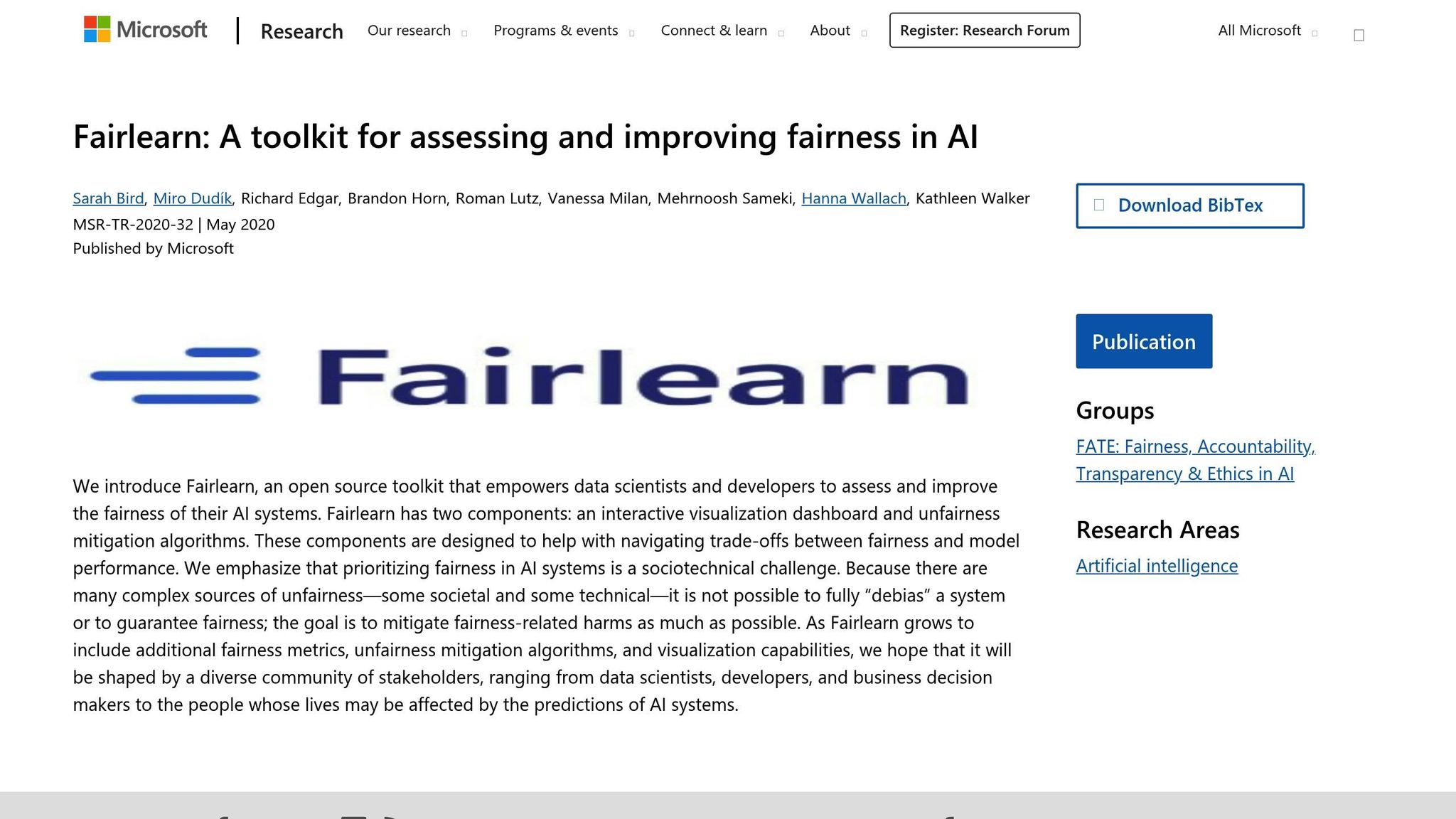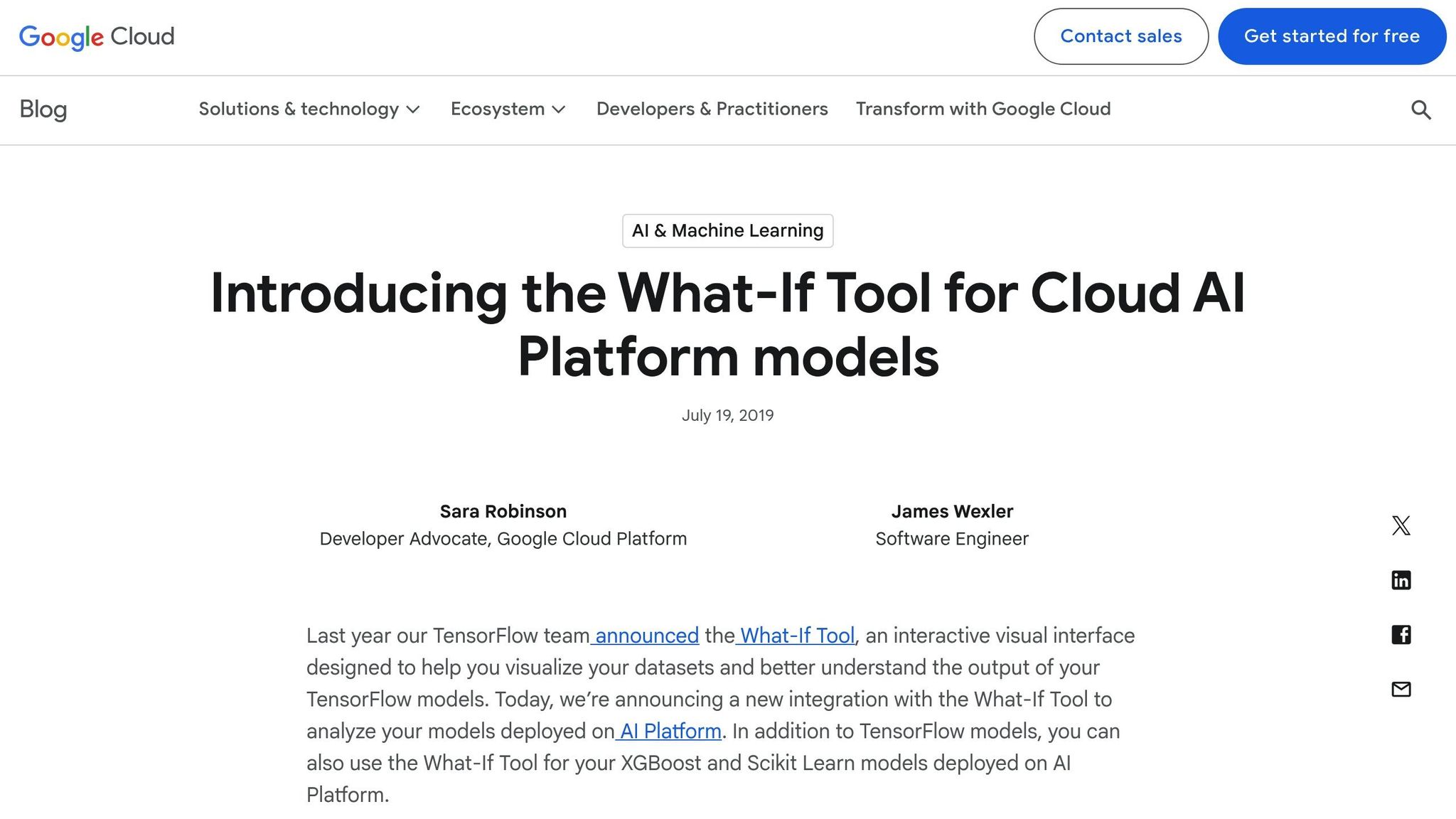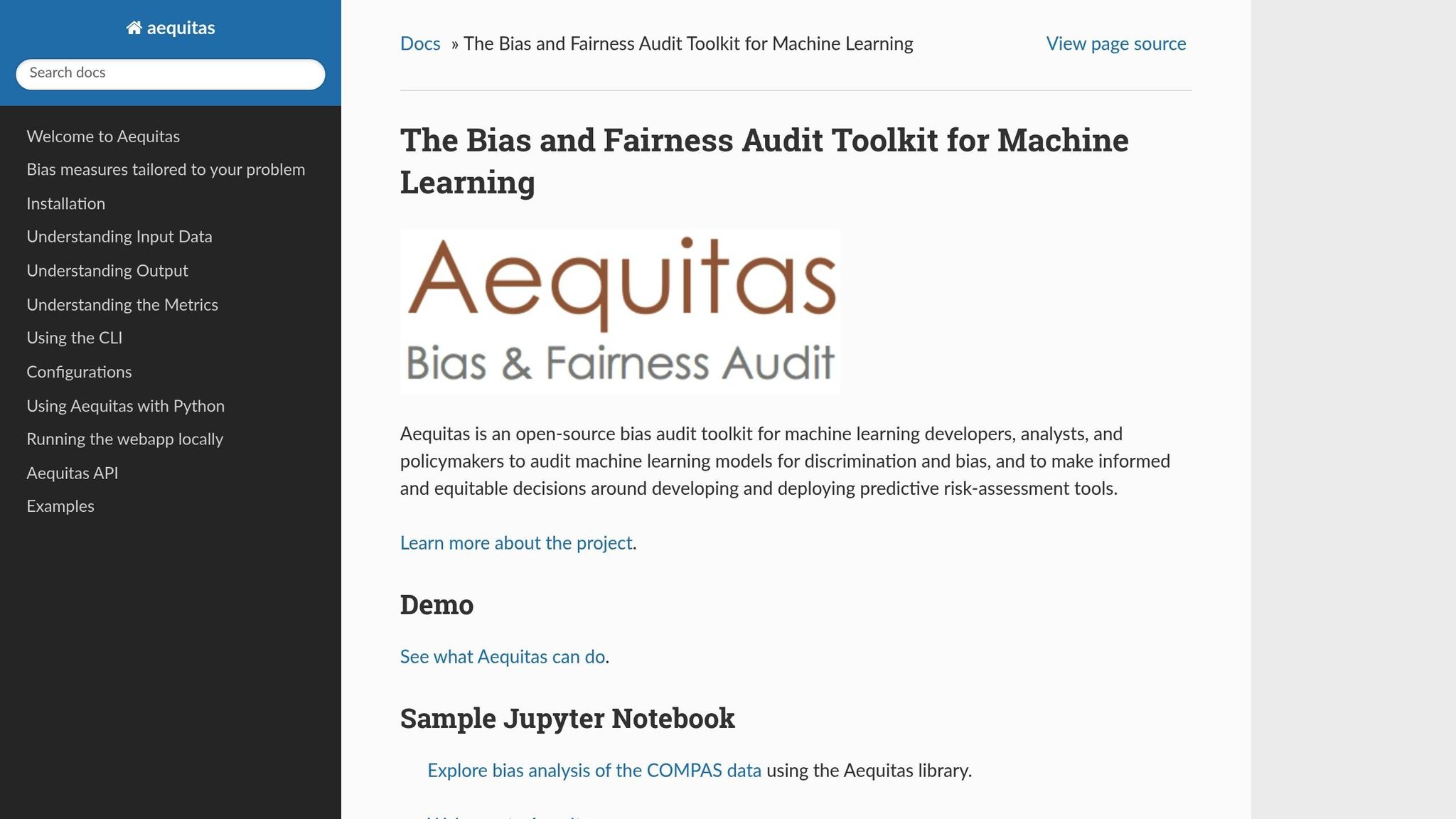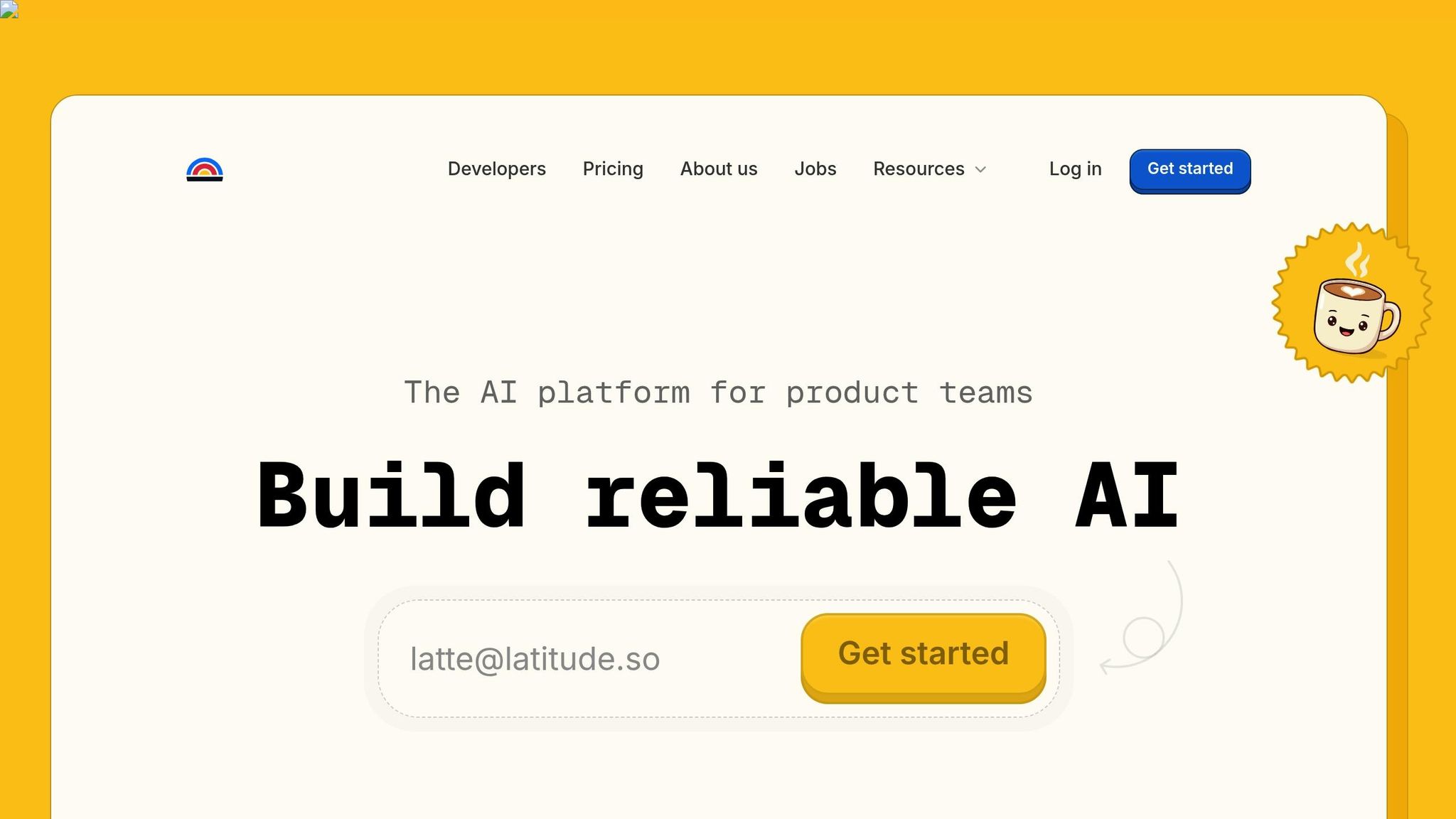Top Tools for Post-Hoc Bias Mitigation in AI
Explore essential tools for mitigating bias in AI systems, ensuring compliance and fairness without retraining models.

When AI models show bias, retraining them isn't always an option. Post-hoc bias mitigation tools offer a way to adjust outputs without retraining, helping businesses stay compliant with regulations like the U.S. Algorithmic Accountability Act. Here are six tools that can help:
- AI Fairness 360: IBM's open-source toolkit with 70+ fairness metrics and algorithms for adjusting predictions.
- Fairlearn: Microsoft's Python library for tweaking outputs and visualizing bias metrics.
- What-If Tool: Google's interactive tool for exploring and manually adjusting model behavior.
- Aequitas: A diagnostic tool for auditing bias and generating detailed reports.
- Activation Steering: A neural-level approach to reducing bias in large-scale AI models.
- Latitude: A no-code platform for collaborative bias mitigation during AI development.
Each tool has unique strengths, from easy integration to advanced metrics. For quick fixes, What-If Tool or Fairlearn works well. For deeper analysis, AI Fairness 360 and Aequitas are better. Advanced users may prefer Activation Steering, while Latitude suits teams needing collaborative workflows.
Quick Comparison:
| Tool | Key Features | Ease of Use | Best For |
|---|---|---|---|
| AI Fairness 360 | Metrics, post-processing algorithms | Moderate | Comprehensive bias detection and mitigation |
| Fairlearn | Exponentiated Gradient Reduction, dashboards | Moderate | Quick adjustments and visualizations |
| What-If Tool | Interactive counterfactual analysis | Easy | Non-technical users exploring bias |
| Aequitas | Auditing reports, intersectional analysis | Moderate | Diagnosing bias in predictions |
| Activation Steering | Neural-level bias reduction | Advanced | Complex AI models |
| Latitude | Collaborative, zero-code platform | Easy | Teams addressing bias during development |
Choosing the right tool depends on your technical expertise, workflow, and compliance needs. Combining tools often yields the best results, ensuring models are both accurate and equitable.
1. AI Fairness 360 (AIF360)
AI Fairness 360 (AIF360) is an open-source toolkit developed by IBM Research to identify and address bias in AI systems. It provides more than 70 fairness metrics and 11 algorithms for mitigating bias, covering various stages of the machine learning process. Notably, it includes post-hoc methods that adjust model predictions after training, enabling fairness improvements without the need for retraining the entire model. This makes it a versatile tool for tackling fairness challenges in AI.
Post-hoc Bias Mitigation Methods
One of the standout features of AIF360 is its post-processing algorithms, which refine model predictions to enhance fairness. By concentrating on the output stage, these methods allow for real-time adjustments to counteract bias. This is particularly useful when data distributions change or new fairness concerns emerge, ensuring the system remains responsive and equitable.
Supported Bias Metrics
AIF360 uses specific metrics to measure fairness, helping to identify and address group-level disparities. For example, it evaluates demographic parity, which ensures predictions are evenly distributed across protected groups, and equalized odds, which requires consistent true positive and false positive rates across these groups. Beyond group fairness, AIF360 also measures individual fairness, providing a more detailed understanding of how predictions impact different populations. Additionally, it examines intersectional fairness, analyzing how multiple protected attributes interact to influence outcomes. This layered approach gives organizations a comprehensive view of fairness in their AI systems.
Ease of Integration into Existing Workflows
Written in Python, AIF360 is compatible with widely used machine learning frameworks like scikit-learn, TensorFlow, and PyTorch. This makes it easy for teams to incorporate bias mitigation into their existing workflows without major system changes. The toolkit also supports continuous monitoring, enabling automated bias testing alongside standard model validation processes. Its open-source nature allows for customization, ensuring it can adapt to the specific needs of different organizations.
Transparency and Auditability
AIF360 prioritizes transparency by providing clear documentation on its fairness metrics and bias mitigation techniques. This ensures that both technical and non-technical stakeholders can understand how fairness is measured and why specific adjustments are recommended. Such clarity not only supports compliance with regulations but also builds trust by making the bias mitigation process auditable and accessible. This emphasis on transparency strengthens AIF360's role in managing bias effectively.
2. Fairlearn

Fairlearn is an open-source Python toolkit created by Microsoft to help identify and reduce bias in machine learning models. It's particularly effective for addressing fairness issues in already-trained models, offering a way to improve outcomes without the need to retrain from scratch.
Post-hoc Bias Mitigation Methods
At the core of Fairlearn's approach is its Exponentiated Gradient Reduction algorithm. This method adjusts model outputs after training to meet fairness constraints. It works by tweaking decision thresholds or reweighting predictions, aiming to reduce disparities among demographic groups. These adjustments are designed to fit seamlessly into production workflows, helping organizations address fairness concerns efficiently.
Bias Metrics Supported by Fairlearn
Fairlearn provides tools to measure fairness using various metrics, including:
- Demographic parity: Ensures that positive prediction rates are consistent across different groups.
- Equalized odds: Looks at differences in both true positive and false positive rates between groups.
- Equal opportunity: Focuses specifically on ensuring equal true positive rates.
- Predictive parity: Evaluates whether the accuracy of positive predictions is consistent across groups.
To make these metrics more actionable, Fairlearn offers visualizations that highlight disparities, making it easier to understand and communicate fairness issues.
Seamless Integration with Existing Systems
Fairlearn is built for easy adoption, offering scikit-learn-compatible APIs that fit directly into Python-based machine learning workflows. For organizations using Microsoft's Azure Machine Learning, Fairlearn integrates directly, providing access to fairness dashboards and tools. This integration allows users to monitor bias metrics alongside standard performance metrics, streamlining the process of identifying and addressing fairness issues.
Transparency and Accountability
Transparency is a key feature of Fairlearn. It generates detailed visualizations and reports that document fairness metrics before and after mitigation. These reports are especially valuable for organizations subject to U.S. regulations like the Equal Employment Opportunity Commission (EEOC) and the Fair Credit Reporting Act (FCRA).
As an open-source tool, Fairlearn ensures that its algorithms and calculations are fully accessible for review. This openness supports compliance with both regulatory and ethical standards. For industries where algorithmic decisions carry legal or ethical weight, Fairlearn's clear documentation and reproducible workflows provide the accountability needed to build trust and meet audit requirements.
3. What-If Tool (WIT)

The What-If Tool (WIT) is an open-source visual interface from Google designed to help analyze machine learning models for bias. Unlike tools that rely solely on algorithms, WIT provides an interactive, visual way for both technical experts and non-technical users to explore how models behave. This hands-on approach complements algorithmic methods by offering a more intuitive perspective on potential biases.
Post-hoc Bias Mitigation Methods
WIT supports post-hoc bias mitigation by allowing users to perform manual counterfactual analysis. Essentially, users can tweak inputs or thresholds to see how these changes affect fairness metrics. This interactive process helps identify sources of bias and informs more precise strategies to address them.
Key Bias Metrics
The tool visualizes important fairness metrics, such as demographic parity and equalized odds. It does this by slicing datasets based on protected attributes, offering a clearer understanding of how the model performs across different groups.
Seamless Integration with Existing Tools
WIT fits neatly into existing workflows, supporting popular machine learning frameworks like TensorFlow, scikit-learn, and XGBoost. It can be used as a Jupyter extension or as a standalone web app, though it works best within the Google ecosystem.
Promoting Transparency and Auditability
Transparency is a key focus of WIT. Its visual explanations make it easier to understand how models behave, and users can document their findings directly within the tool. While WIT doesn't automate regulatory reporting, its visual outputs can be valuable during audits, showcasing a proactive effort toward ensuring fairness in algorithms.
4. Aequitas

Aequitas is an open-source toolkit designed to audit and assess bias in machine learning systems. Developed by the Center for Data Science and Public Policy at the University of Chicago, this tool focuses on identifying and reporting bias rather than directly fixing it. Think of it as a diagnostic tool - it helps pinpoint where bias exists so you can decide the best way to address it. This makes it a great complement to tools that directly adjust model predictions.
Post-hoc Bias Mitigation Methods
Instead of altering model predictions automatically, Aequitas takes an audit-first approach. By analyzing prediction outputs alongside demographic data, it identifies disparities across different groups and generates detailed fairness reports. These insights can guide your next steps, whether that involves adjusting thresholds, post-processing outputs, or retraining your model. This method is especially helpful when you need a clear understanding of your system's biases before making changes.
Supported Bias Metrics
Aequitas evaluates a wide range of fairness metrics, many of which align with U.S. regulatory standards. It examines demographic parity to ensure outcomes are evenly distributed among groups and assesses parity in false positive and false negative rates. The toolkit also measures equal opportunity and predictive parity, giving you a full picture of fairness. Additionally, its intersectional analysis evaluates fairness across multiple protected attributes, offering a deeper level of insight.
Ease of Integration into Existing Workflows
Aequitas is easy to incorporate into your current workflow. It operates as a Python library, accepts CSV files for predictions, and integrates seamlessly into existing data pipelines. Its user-friendly reports are accessible to both technical and non-technical stakeholders, fostering collaboration across teams when addressing bias-related challenges.
Transparency and Auditability
One of Aequitas's strengths is its ability to produce detailed, easy-to-interpret reports that document fairness metrics for each demographic group. These reports include visualizations and summary tables, breaking down complex fairness concepts in a way that’s straightforward for all stakeholders. The open-source nature of the toolkit adds another layer of transparency, allowing users to review the calculations behind each metric and customize the analysis as needed. This is especially valuable for organizations in regulated industries or government agencies that need to demonstrate accountability and compliance.
Aequitas has already made an impact in real-world scenarios, particularly in public policy and criminal justice. For instance, several U.S. city governments have used it to audit risk assessment models for pretrial release decisions. These audits uncovered disparities in false positive rates, leading to policy changes aimed at improving fairness.
5. Activation Steering
Activation steering is a cutting-edge approach to reducing bias in AI models by directly working with their internal neural representations. Unlike traditional methods that adjust training data or tweak final outputs, this technique intervenes at the activation level - the internal processes of the model itself. By addressing bias at its neural source, activation steering complements earlier tools while offering a fresh angle for tackling fairness challenges.
One reason this method is gaining attention is its practicality for large-scale models. Retraining complex models can be prohibitively expensive and time-consuming, but activation steering sidesteps this by offering a post-hoc solution. For organizations managing advanced AI systems, this approach provides an effective way to reduce bias without the need for costly retraining. Let’s explore how activation steering works, how it integrates into workflows, and why it’s a transparent, auditable solution for bias mitigation.
Post-hoc Bias Mitigation Methods
Activation steering uses targeted techniques to identify and adjust bias within a model’s neural representations. It employs several strategies, including:
- Representation steering: Detects activation patterns linked to bias and modifies them in real time.
- Contrastive activation analysis: Compares activation patterns across different groups to identify discriminatory features, enabling precise corrections.
- Dynamic intervention: Adjusts activations during inference, allowing the model to adapt to specific inputs and make more context-aware corrections.
These methods are far more flexible than static post-processing techniques. For example, recent studies have shown that steering vectors can reduce biased content in generated text by as much as 30%.
Supported Bias Metrics
Activation steering works to improve fairness by addressing multiple metrics, including:
- Demographic parity: Ensures outcomes are evenly distributed across groups.
- Equalized odds: Balances error rates for all groups.
- Counterfactual fairness: Verifies that predictions remain consistent when sensitive attributes are altered.
- Intersectional bias analysis: Examines how multiple attributes interact to produce bias.
By working at the activation level, this approach allows for a detailed examination of how these fairness metrics align, ensuring both group-level and individual fairness.
Ease of Integration into Existing Workflows
Activation steering is designed to integrate smoothly into existing AI pipelines. For models built with frameworks like TensorFlow or PyTorch, the process involves profiling activation layers, applying hooks to modify activations, and defining steering policies. This modular setup allows teams to target specific components of a model without requiring a full system overhaul.
While this method does require intermediate to advanced knowledge of machine learning - particularly neural network architectures - new tools and libraries are making it easier to implement. Pre-built components for common model types are becoming available, lowering the barrier to entry. And since activation steering operates during inference rather than training, it can be applied selectively, minimizing disruption to the overall infrastructure.
Transparency and Auditability
Transparency is one of the standout features of activation steering. The method provides detailed audit trails that document which activations were modified, the extent of the adjustments, and their impact on fairness metrics. This level of clarity aligns with regulatory standards like EEOC and FCRA requirements in the U.S., making it easier for organizations to demonstrate compliance.
That said, translating these highly technical insights for non-technical stakeholders can be a challenge. While activation steering generates rich data about a model’s behavior, organizations need effective visualization tools and clear documentation to explain these interventions in practical, business-friendly terms. Additionally, teams must validate any adjustments rigorously to ensure they don’t inadvertently introduce new biases while addressing existing ones.
6. Latitude

Latitude takes a fresh approach to addressing bias in AI systems by emphasizing collaboration and proactive measures. Unlike traditional post-hoc methods that focus on fixing issues after they arise, Latitude is an open-source platform designed to bring together domain experts and engineers. Its goal? To create production-ready large language model (LLM) features while embedding bias awareness from the start. By using a prompt-first methodology, Latitude encourages teams to tackle fairness concerns during development instead of relying on reactive solutions.
Easy Integration with Existing Workflows
One of Latitude's standout features is its zero-code design, which makes it accessible to users of all technical skill levels. Whether you're a seasoned engineer or a non-technical domain expert, the platform is built to fit seamlessly into your existing processes. Latitude connects with thousands of apps and tools, simplifying the integration of bias mitigation into day-to-day workflows. All users need to do is describe their goals in plain English, and the platform translates those instructions into actionable AI configurations. This approach allows domain experts to play an active role in addressing bias without needing advanced technical knowledge. Plus, as an open-source tool, Latitude offers a free tier, giving organizations the flexibility to explore and tailor the platform to their unique needs.
Built-In Transparency and Auditability
Transparency is at the heart of Latitude's design. As an open-source platform, it naturally promotes visibility into AI development processes. It includes features like run tracking, error insights, logs, and customizable checks that create detailed audit trails. The platform's human-in-the-loop capabilities add another layer of oversight, enabling experts to monitor and adjust AI decisions as they happen. These tools work together to provide organizations with the means to explain their AI systems' behavior clearly to stakeholders and regulators. By combining open-source transparency with robust logging and collaborative oversight, Latitude ensures accountability throughout the AI development lifecycle.
Tool Comparison Table
Choosing the right tool depends on your specific needs, technical expertise, and organizational goals. Below is a breakdown of how each tool performs across critical criteria:
| Tool | Supported Bias Metrics | Ease of Integration | Documentation Quality | Pricing/Licensing | Key Limitations |
|---|---|---|---|---|---|
| AI Fairness 360 | Demographic parity, equalized odds, disparate impact, individual fairness, intersectional bias | Medium - Python-based, works with scikit-learn, TensorFlow, PyTorch | High - Extensive tutorials, active community | Open-source, free (Apache 2.0) | Steep learning curve, requires significant configuration |
| Fairlearn | Demographic parity, equalized odds, fairness-accuracy trade-offs | Medium - Python integration with popular ML frameworks | High - Comprehensive guides, beginner-friendly | Open-source, free (MIT) | Requires ML expertise, doesn't cover all bias types |
| What-If Tool | False positive/negative rates, subgroup performance, interactive visualizations | Low - No-code, browser-based interface | High - User-friendly guides, interactive demos | Free to use | Limited to TensorFlow/Keras, tied to Google ecosystem |
| Aequitas | Group fairness, disparate impact, intersectional bias metrics | High - Command-line driven, batch processing | Medium - Clear audit workflows, smaller community | Open-source, free | Not designed for real-time monitoring, batch audits only |
| Activation Steering | Customizable for LLM-specific biases | High - Requires deep model access, custom implementation | Low - Mostly academic papers, fragmented resources | Open-source research code | Needs specialized expertise, limited practical applications |
| Latitude | Custom metrics via collaborative workflows | Medium - Zero-code design, integrates with existing tools | High - Collaborative documentation, user-friendly onboarding | Open-source, free | Effectiveness depends on team collaboration, no out-of-the-box bias metrics |
Additional Insights for Tool Selection
If meeting U.S. regulatory standards is a priority, tools like AI Fairness 360 and Aequitas align with laws such as the Equal Credit Opportunity Act and EEOC guidelines. These tools are particularly useful for organizations aiming to ensure compliance.
While most tools are free, consider the costs associated with implementation. For example, Activation Steering demands significant development resources, whereas the What-If Tool offers quick deployment with minimal setup.
Your team’s expertise also plays a major role in determining the right fit. If your team has limited machine learning experience, starting with What-If Tool or Latitude is a smart choice due to their user-friendly interfaces. On the other hand, teams with advanced technical skills can take advantage of the robust features in AI Fairness 360. For those with deep ML expertise, Activation Steering offers flexibility but requires significant effort to implement.
Finally, combining tools often leads to the best results. For example, you might use one tool for initial bias detection, another for detailed analysis, and a third for ongoing monitoring and collaboration. This multi-tool approach ensures a more comprehensive and effective bias mitigation strategy.
Conclusion
Selecting the right post-hoc bias mitigation tool is crucial for creating AI systems that are both fair and compliant. The success of your bias mitigation efforts hinges on aligning the tools with your unique requirements, technical capabilities, and any applicable regulatory standards, as outlined in this review.
Bias is not static - it changes as data, behaviors, or societal norms evolve. That’s why regular audits are indispensable. A 2025 systematic review focusing on bias mitigation in healthcare AI found that using open-sourced data and involving multiple stakeholders were among the most effective methods for addressing bias across diverse populations. This highlights the need for ongoing evaluation rather than relying on one-time fixes.
Continuous monitoring also lays the groundwork for effective human oversight, which remains a critical component of bias mitigation. Human-in-the-loop systems or tools that encourage collaboration between engineers and domain experts can help maintain fairness and transparency in AI. Platforms like Latitude play a key role in facilitating such collaboration, ensuring bias mitigation strategies stay relevant throughout the AI lifecycle.
Involving diverse stakeholders further strengthens mitigation efforts. By including underrepresented or directly affected groups during AI development and deployment, you can address practical concerns and create more inclusive solutions. For example, research shows that race/ethnicity and sex/gender are the most frequently targeted attributes in bias mitigation studies - appearing in 12 and 10 of 17 studies, respectively. This underscores the importance of taking a broad, inclusive approach.
Lastly, it’s essential to document and monitor the outcomes of your mitigation strategies. While post-hoc methods offer flexibility, they may not always match the effectiveness of pre- or in-training approaches. The goal is to improve fairness without sacrificing performance or introducing new forms of bias.
FAQs
What sets post-hoc bias mitigation tools apart from pre-training or in-training methods?
Post-hoc bias mitigation tools are designed to tackle bias in AI systems after the model has already been trained. Unlike pre-training approaches that focus on cleaning and preparing the data or in-training methods that tweak the model's learning process, post-hoc tools work directly with the outputs of a fully trained model. Their goal? To adjust these outputs to promote fairness and minimize unintended bias in practical, real-world applications.
What makes post-hoc methods so appealing is their efficiency. Since they don't require retraining the entire model, they save both time and computational resources. This makes them a smart choice for systems that are already in production, where retraining isn't always a realistic option.
What should I consider when selecting a post-hoc bias mitigation tool for my organization?
When selecting a post-hoc bias mitigation tool, there are a few key factors to keep in mind. Start by assessing how easily the tool integrates with your current AI systems. It's also essential to determine whether it effectively tackles the specific types of bias that are most relevant to your use case. Another consideration is the transparency of the tool's methods - understanding how it works can make a big difference. Finally, think about whether the tool is open-source or commercial, as this choice can influence both customization possibilities and long-term costs.
For organizations aiming to create dependable AI systems, platforms like Latitude can play a crucial role. Latitude facilitates collaboration between domain experts and engineers, simplifying the process of developing production-ready AI features while addressing issues like bias mitigation along the way.
How can using multiple bias mitigation tools improve the fairness and compliance of AI models?
Using multiple bias mitigation tools together can help tackle bias in AI models from various perspectives. Each tool often employs distinct methods or algorithms, and combining them allows you to detect and address a wider array of biases within your system.
This approach also supports adherence to ethical guidelines and regulatory requirements. By applying diverse techniques to evaluate and adjust your AI models, you can build systems that are more aligned with societal values and legal standards, promoting fairness and equity.
